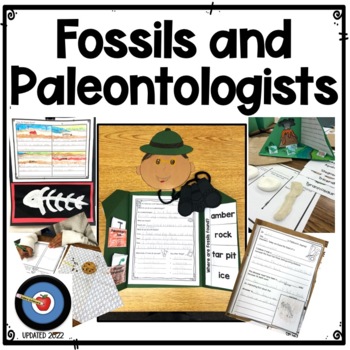Paleontologist Lapbook with Fossil Study for Dinosaur Week!
- PDF
Description
Have some fun with dinosaurs! Updated in 2022!
Students learn about dinosaurs by making a paleontologist fieldwork journal. Dinosaurs can be researched independently, with partners, in small group, or whole class. There is a Digging Up Dinosaurs Layer Book for students to read and make diagrams for 5 dinosaur types. Students can use this book or other research to record main characteristics of each dinosaur and make a sketch for their fieldwork journals. After a week of researching, you can simply bind the journals together with a paper bag cover and twine.
Your students can learn what a paleontologist does by completing the fun lap book. There is information on where fossils are found, tools a paleontologist uses, and types of dinosaurs. Students learn to think like a paleontologist by completing writing activities that explain how conclusions are made. They also complete an opinion writing to persuade someone to become a paleontologist. The lap book can be decorated with each student's head and a doctor name tag. My students loved seeing their name with Dr. ___.
There's more persuasive writing with a story connection to Can I Bring My Pterodactyl to School, Ms. Johnson? by Lois G. Grambling.
My students loved completing an imaginative name play with ___asauras and describing themselves as a dinosaur.
We studied bones and did an x-ray art project with My Bones poetry. Easy to prep with Q-tips.
Math Connections include:
-Math Measurement with inches and feet, elapsed time, and problem solving. Students can use more than one way to show how they solved dinosaur/paleontologist themed math problems.
-Measurement recording sheet and cards to measure fossils in inches and centimeters. These can be used in small groups or with partners.
Added in 2022:
- Fossil poster, What are Fossils? worksheet
- Where do we find fossils worksheet and a sheet to illustrate and record main idea from reading. There's a sample of a quick fossil painting that makes a great looking bulletin board.
- Task cards for review or assessment
- Diorama pieces for writing What Happened to the Dinosaurs?
- Why are dinosaurs extinct? informational read
- Types of fossils display sheet and informational reading worksheet
- Cookie Dig worksheet for students to use toothpicks and a chocolate chip cookie to dig out the chips
- Dice activity to draw a dinosaur with each roll
- Odd and Even fossil facts sort - great for small groups
- Group Table Signs
- Vocabulary to post in pocket chart
- Grid reading worksheet
- Fossil painting sheet (white crayon resist)
- Shape-o-saurus worksheet with shapes to color and create a dinosaur with circle, triangle, square, hexagon, pentagon, rhombus, and trapezoid
- Dinosaur word search
- Lesson plan and samples
We had a great dinosaur week!





